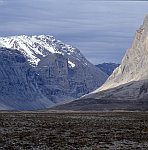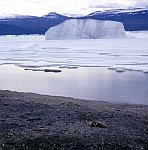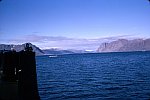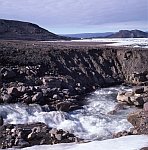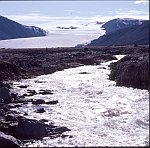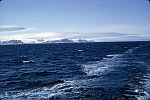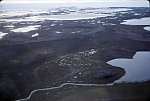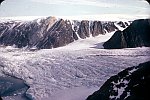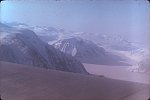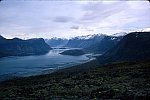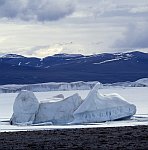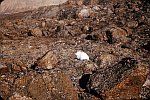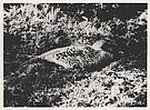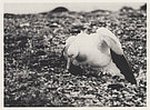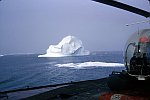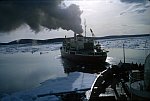Scenes from Nunavut
Author: Judith O. Stoute Page 1 | Page 2 | Page 3
Introduction
Northern Canada, defined as beginning at 60o N - the southern boundary of the Northwest Territories - was first inhabited from about 2000 BC by an ancient people called the pre-Dorset people. They were followed from about 500 BC by the Dorset culture people who in turn were followed from about AD 1000 by the Thule culture people. These early inhabitants were nomadic hunters and fishermen who hunted caribou, game, muskox, seal and walrus in addition to harvesting other species of mammals. Today�s Inuit are the descendants of the Thule culture people.
The land of Nunavut - mainly the home of the Inuk and of a small number of other Aboriginals and non-Aboriginals - was formerly part of the Northwest Territories and it came into being on April 1, 1999. The remaining part of the Northwest Territories is the home of First Nations people, Metis, non-Aboriginals and a small Inuit community (the Innuvialuit). These three groups each speak a different language and have a different cultural experience.
This presentation on Nunavut (meaning �our land�) shows scenes from the central and eastern region of the new territory; it consists of three parts: (1) a brief history of Nunavut, (2) a general description of seven communities and (3) some aspects of the communities.
Geography
Nunavut was created from almost 60% of the eastern half of the Northwest Territories; it has an area of 1,994,000 square kilometres (1999) which is approximately 1/5 of Canada�s land mass and embracing 2/3 of its coastline. Nunavut is a land of rocky tundra, fjords, mountains, plateaus and cliffs. It has abundant fauna and mammals, and mineral and petroleum resources can be found in many areas. Nunavut is unique in that it has three time zones. �Except for areas of persistent ice-free conditions called polynyas ..., virtually all of the northern ocean freezes each winter� (Nunavut, Government of Canada Folder, 1999). Another writer further described this condition: �The central portion of the Arctic Archipelago is a maze of islands and peninsulas, locked together by sea ice that can be crossed by animals and human hunters for most of the year� (McGhee, pp. 94-95). For example, caribou herds crossed a short distance from the easternmost part of the mainland to Baffin Island, and people could traverse other sea ice in the area within a day�s walk. Nunavut has two national parks and another is being planned: Auyuittuq National Park (1976) on Baffin Island - said to be one of the world�s most scenic mountain ranges, Ellesmere Island National Park Reserve (1988) and the forthcoming Sirmilik National Park also on Baffin Island.
Population and Language
In 1999, the population of Nunavut was 27,219 spread across twenty-eight communities with Inuit comprising 85% of the populace and young people under the age of 25 numbering 60%. Inuktitut (meaning �in the manner of the Inuit� and spoken by almost all the Inuk) is one of the territory�s official languages - the others being English and French.
History
�The history of the people of Nunavut is one of astonishingly rapid transformation. Before 1940, they were largely ignored...; it was only in 1939 that Ottawa assumed any formal responsibility for their welfare� (Morrison, p. 183). At that time formal education was lacking, sickness pre-dominated and the main part of their economy - the fur trade - was in decline. After the government became involved, permanent communities began to be set up in the 1950s and 1960s when the �Inuit were urged to abandon their traditional camps and move into settlements� (Nunavut '99, p. 93). Earlier in the 1950s, the government had encouraged the establishing of co-operatives.
The Nunavut Land Claim Agreement and the Nunavut Act
The move to a separate territory began with a claim in 1976 (revised 1977) put forward by the Inuit Tapirisat of Canada (ITC) which was formed in 1971, and twenty-three years later Nunavut was created. For the Inuit, the need to have their own territory was based on the concern for their �values and interests� which they felt were �influenced� by the national government and by external factors regarding certain natural resources.
The process towards the establishing of the new political entity had begun in 1973 with a ruling by the Supreme Court of Canada. Then, as seen above, the process continued with the ITC�s claim calling for ownership of land and a separate territory. This was followed by negotiations with the Canadian and Territorial governments and the Inuit representatives over the next seventeen years, culminating in 1993 with the passage in Parliament of the Nunavut Land Claim Agreement and the Nunavut Act. Throughout the process, the residents of the Northwest Territories were consulted and they gave approval to the deliberations. For example, in a 1982 plebiscite, they voted by 56% in favour of the boundary for the new territory and in 1982, the Inuit of the Eastern Arctic approved the agreement - the Act received 84.7% endorsement.
This land claim agreement was the largest and richest Aboriginal land claim settlement in Canada�s history. The Tunngavik Federation of Nunavut (TFN) which had taken over from the Inuit Tapirisat of Canada in 1982 was the representative for the Inuit of the Eastern Arctic in the long negotiations with the governments of Canada and the Northwest Territories. In essence, the 1993 Land Claim Agreement gave to the people of Nunavut ownership of a certain percentage of the land comprising more than 350,000 square kilometres including 36,000 square kilometres with mineral rights and more than one billion dollars in compensation over fourteen years. The 1993 Act gave to the people a new territory which encompasses an area of two million square kilometres.
Before the new territory came into being an advisory body was formed in 1994 for its creation; this body, the Nunavut Implementation Commission, was succeeded by the Office of the Interim Commissioner in 1997. Then in February 1999, the first elections were held, and shortly after in April 1999, the new government was installed with its flag and coat of arms unveiled. In May of the following year, its floral emblem - the purple saxifrage - was chosen.
The Inuit people of Nunavut make up the majority of the residents. They are a �consistent� people who are not apt to change their minds �easily�. For example, the creation of a separate territory was the goal right from the very beginning. This demand was firmly tied to the land claim. However, it must be noted that the process leading to the Nunavut Land Claim Agreement and the Nunavut Act was conducted through �positive negotiations and planning� by Canada, the Northwest Territories and the Inuit of the Central and Eastern Arctic. The leaders of the Tunngavik Federation of Nunavut themselves �quietly and persistently advanced [their] arguments� (Canadian Geographic, p. 13, 1999). Nunavut Day is on July 9.
The Government
Nunavut has a representative government whereby all the residents can vote and seek election; it is a form of self-government by virtue of its residents being mainly Inuit (85%). Some particular features of the new government are: (1) there are no political parties, (2) government is by consensus, (3) the 19 members of the Legislative Assembly elect the Premier, Speaker and the Cabinet by secret vote - the Opposition is made up of the members who are not Ministers and (4) elections are set for every five years. Also of particular note is that �traditional knowledge of Elders is incorporated into government systems, so that Inuit cultural values are an integral part of decision-making processes� (Wonders, p. 345). You will recall from above that the concern for their values as well as their interests led to the pursuit of a separate territory.
The government of Nunavut is highly decentralized with ten departments, each headed by a Minister, in eleven communities. These communities are grouped under three administrative regions; namely, Qikiqtaaluk (Baffin Island), Kivalliq (Keewatin) and Kitikmeot (Western). The Nunavut Tunngavik Incorporated (NTI), an elected body of four members by all residents 16 years and over, is the �Guardian� of the Land Claim Agreement which administers it for the Inuit. Regional development corporations were established by the NTI including the Inuit Heritage Trust to regulate archaeological activity so that sacred artefacts and remains are not �removed to museums throughout the world.� At the start-up of the new territory, the government of Canada extended to the government of Nunavut about 90% of the money for its first budget, and it is important to note that this money was granted unconditionally.
Nunavut has 28 communities, its capital and largest city is at Iqaluit which was chosen over Rankin Inlet by 60% of the residents. The other communities are of various sizes situated on or near the shore - only one is inland on a lake. Formerly the Inuit were seasonal nomadic hunters and fishermen, and in 1999 - to a certain extent - 59% still relied on hunting and fishing for their meat. Indeed for many people, Arctic char, caribou and seal remain primary foods.
Modernization in Nunavut has not changed some things; for example, a writer wrote of the Inuit that (1) �despite their modernity, their ancestors would recognize in them the spirit and freedom that once they lived� (Nunavut �99, p. 65), (2) �[t]he heart of Inuit society was ever the family, a unit based upon mutual respect� (Nunavut �99, p. 62), (3) Elders are still sought out for advice, (4) family gatherings on the land for the Spring Hunt are still done and (5) hunting trips with dog teams are still made.
�The creation of Nunavut restores to Inuit their self-determination as practised for thousands of years before the arrival of Europeans� (Nunavut, Government of Canada Folder, 1999), and the people will earnestly strive to achieve their goal of self-sufficiency, now with a combination of �ancient values� and �contemporary government practices.�
